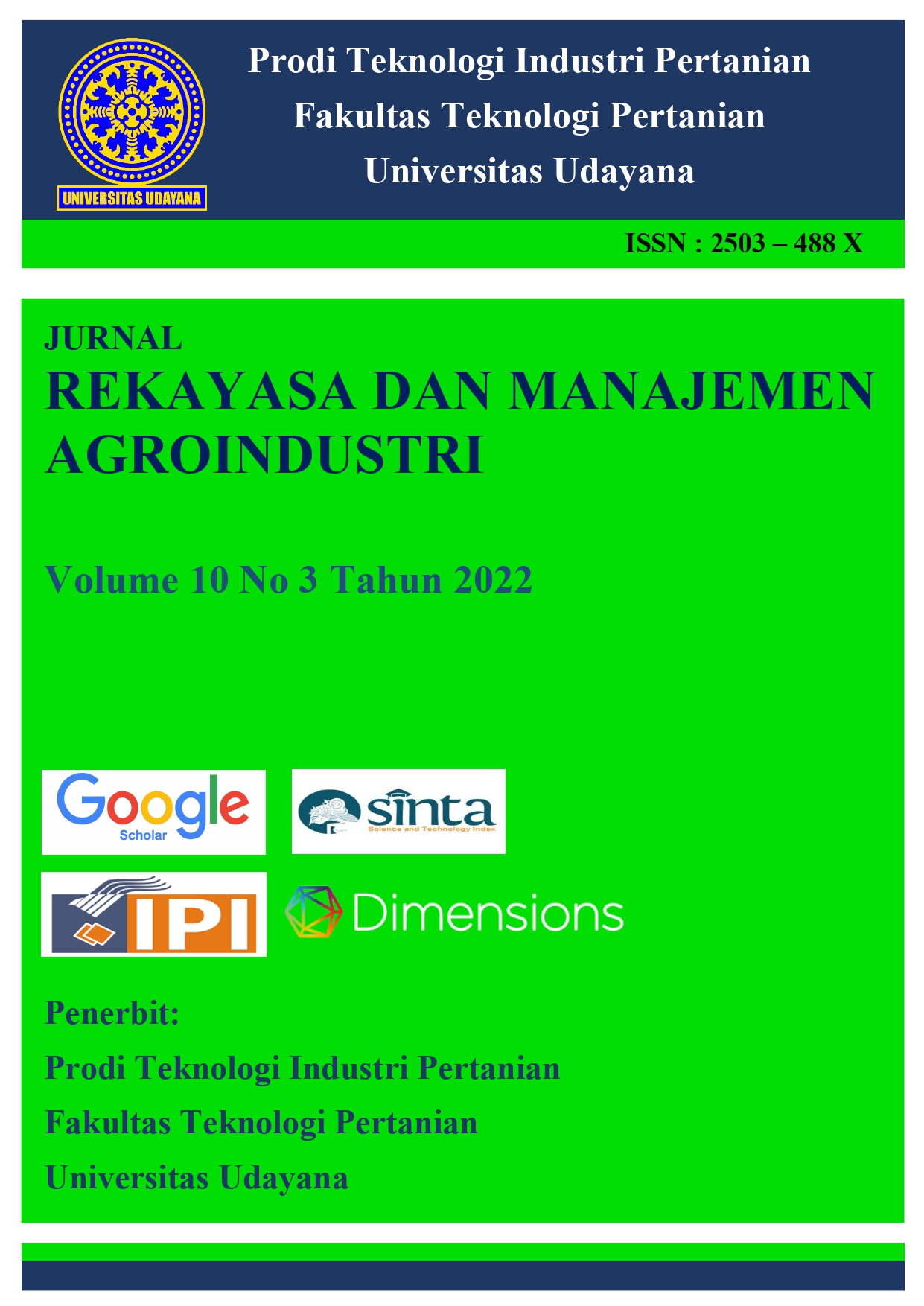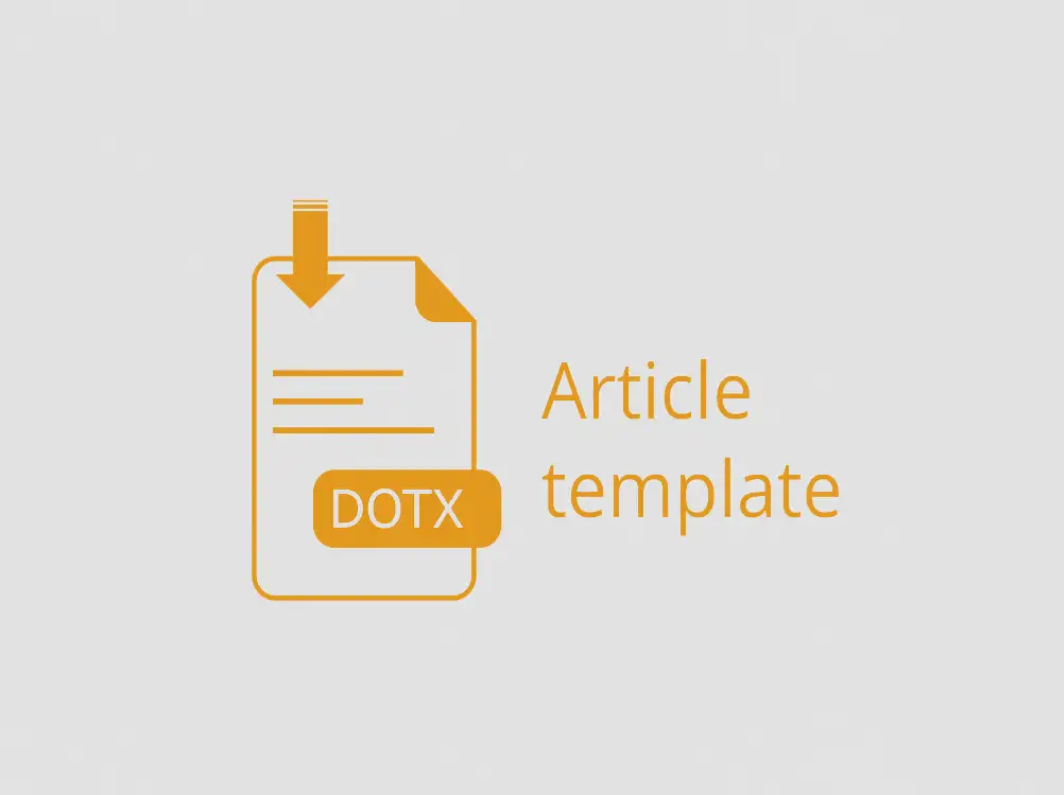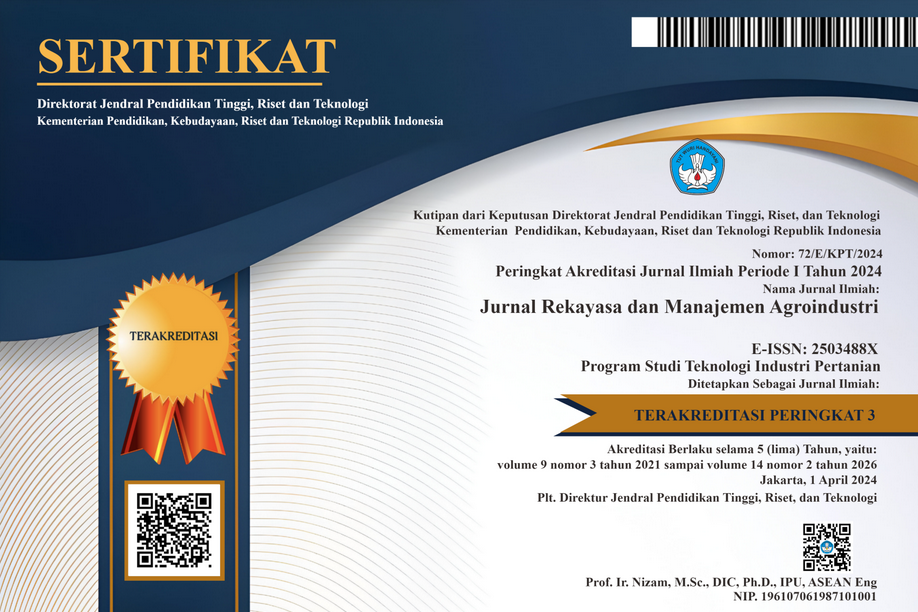ISOLASI SELULOSA DARI SERAT SABUT KELAPA (Cocos nucifera L.) PADA VARIASI SUHU DAN WAKTU PROSES BLEACHING DENGAN ASAM PERASETAT
Abstract
Cellulose is a chemical component of lignocellulose that can be found in most cell walls and woody parts of plants. One of the plants that has a high cellulose content is coco fiber, which is 43.44%. However, the potential of cellulose content in coco fiber is still not optimally utilized. This study aims to determine the effect of the temperature and time of the bleaching process using peracetic acid (PA) on the characteristics of the cellulose produced, as well as to determine the best combination of temperature and time for the bleaching process with PA to produce coco fiber cellulose. This study used a randomized block design with two factors, that were temperature (60°C, 80°C, and 100°C) and time (30 minutes and 60 minutes). Data were analyzed by analysis of variance and continued with Duncan's multiple comparison test. Variables observed were yield, degree of whiteness, content of cellulose, hemicellulose, and lignin. The results showed that the treatment temperature and time of the bleaching process using PA had a significant effect on all observed variables. The interaction between temperature and time of the bleaching process had a significant effect on whiteness, cellulose, hemicellulose, and lignin content, but did not significantly affect the yield content of coco fiber. The best treatment to produce cellulose was obtained by using PA at a temperature of 100°C and a time of 60 minutes. The characteristics were 35.38±0.32% yield, 84.77±0.81% degree of whiteness, 83.14±0.22% cellulose, 6.60±0.51% hemicellulose, and 4.23±0.55% lignin.
Downloads
References
[2] dan R. J. A. P. Zuidar, A.S., S. Hidayati, “Kajian Delignifikasi Pulp Formacell dari Tandan Kosong Kelapa Sawit menggunakan Hidrogen Peroksida (H2O2) dalam Media Asam Asetat,” J. Teknol. Ind. dan Has. Pertan., vol. 19, no. 2, pp. 194–204, 2014.
[3] dan L. S. Sena, P.W., G.P. Ganda Putra, “Karakterisasi selulosa dari kulit buah kakao (Theobroma cacao L.) pada berbagai konsentrasi hidrogen peroksida dan suhu proses bleaching,” J. Rekayasa dan Manaj. Agroindustri, vol. 9, no. 3, pp. 288–299, 2021.
[4]M. K. M. Verma, D., P. Gope, “Coir Fiber Reinforcement and Application in Polymer Composites: A Review,” J. Mater. Environ. Sci., vol. 4, no. 2, pp. 263–276, 2012.
[5]B. P. Statistik, Produksi Tanaman Perkebunan (Ribu Ton), 2019-2021. Jakarta: Jakarta: Badan Pusat Statistik, 2021.
[6]T. Indahyani, “Pemanfaatan Limbah Sabut Kelapa pada Perencanaan Interior dan Furniture yang Berdampak pada Pemberdayaan Masyarakat Miskin,” J. Hum., vol. 2, no. 1, pp. 15–23, 2011.
[7] dan E. H. Fatriasari, W., N. Masruchin, Selulosa: Karakteristik dan Pemanfaatannya. Jakarta: Jakarta: LIPI Press, 2019.
[8] and R. A. R. Malmiri, H.J., A. Osman, C.P. Tan, “Evaluation of effectiveness of three cellulose derivative-based edible coatings on changes of physico-chemical characteristics of ‘Berangan’ banana (Musa sapientum cv. Berangan) during storage at ambient conditions,” Int. Food Res. J., vol. 18, no. 4, pp. 1381–1386, 2011.
[9] dan Y. Y. Prasetya, I., S.H. Istiqomah, “Pembuatan bioplastik berbahan bonggol pisang dengan penambahan gliserol,” J. Tek. ITS, vol. 8, no. 2, pp. 73–80, 2016.
[10] dan M. I. B. Pratiwi, R., D. Rahayu, “Pemanfaatan Selulosa dari Limbah Jerami Padi (Oryza sativa) sebagai Bahan Bioplastik,” J. Sains dan Teknol. Farm. Indones., vol. 3, no. 3, pp. 83–91, 2016.
[11] dan S. A. Tamiogy, W.R., A. Kardisa, Hisbullah, “Pemanfaatan Selulosa dari Limbah Kulit Buah Pinang sebagai Filler pada Pembuatan Bioplastik,” J. Rekayasa Kim. dan Lingkung., vol. 14, no. 1, pp. 63–71, 2018.
[12] dan N. H. Elean, S., C. Saleh, “Pembuatan Film Biodegradable Dari Pati Biji Cempedak Dan Carboxy Methyl Cellulose Dengan Penambahan Gliserol,” J. At., vol. 3, no. 2, pp. 122–126, 2018.
[13] dan W. S. Hidayati, S., Zulferiyenni, “Optimasi pembuatan biodegradable film dari selulosa limbah padat rumput laut Eucheuma cottonii dengan penambahan gliserol, kitosan, CMC dan tapioka,” J. Pengolah. Has. Perikan. Indones., vol. 22, no. 2, pp. 340–354, 2019.
[14]D. Nawangsari, “Isolasi dan karakterisasi selulosa mikrokristal dari ampas tebu (Saccharum officinarum L.),” J. Farm. Indones., vol. 16, no. 2, pp. 67–72, 2019.
[15] dan N. A. Saleh, A., M.M.D. Pakpahan, “Pengaruh Konsentrasi Pelarut, Temperatur dan Waktu Pemasakan pada Pembuatan Pulp dari Sabut Kelapa Muda,” J. Tek. Kim., vol. 16, no. 3, pp. 35–44, 2009.
[16]I. K. Wardani, A.K., “Pretreatment Ampas Tebu (Saccharum oficinarum) sebagai Bahan Baku Bioetanol Generasi Kedua,” Tesis. Tidak Dipublikasikan. Fakultas Teknologi Pertanian UB, Surabaya, 2012.
[17] dan F. M. I. Kurniaty, I., H.H. Ummul, Y. Devi, “Proses Delignifikasi menggunakan NaOH dan Amonia (NH3) pada Tempurung Kelapa,” J. Integr. Proses, vol. 6, no. 4, pp. 197–201, 2017.
[18] dan I. M. Y. S. G. Gunam, I.B.W., K. Buda, “PENGARUH PERLAKUAN DELIGNIFIKASI DENGAN LARUTAN NaOH DAN KONSENTRASI SUBSTRAT JERAMI PADI TERHADAP PRODUKSI ENZIM SELULASE DARI Aspergillus niger NRRL A-II, 264,” J. Biol., vol. 14, no. 1, pp. 55–61, 2010.
[19]A. Wildan, “Studi Proses Pemutihan Serat Kelapa Sebagai Reinforced Fiber,” Tesis. Tidak Dipublikasikan. Program Pascasarjana Universitas Diponegoro, Semarang., 2010.
[20]S. Hidayati, R. Sugiharto, and A. S. Zuidar, “Karakteristik Pulp Hasil Pemutihan Dari Tandan Kosong Kelapa Sawit Hasil Pemasakan Yang Menggunakan Limbah Lindi Hitam Siklus Ketiga,” J. Trop. Upl. Resour., vol. 01, no. 01, pp. 103–108, 2019.
[21] and A. K. Chattopadhyay, S. N., N.C. Pan, A.N. Roy, K.K. Samanta, “Two-Step Bleaching of Jute Yarn and Fabric Using Hydrogen Peroxide and Peracetic Acid,” J. Nat. Fibers, vol. 19, no. 3, pp. 1159–1167, 2020.
[22] and S. M. Mantovan, J., G.A.G. Giraldo, B.M. Marim, J.O.F.K. Kishima, “Valorization of orange bagasse through one-step physical and chemical combined processes to obtain a cellulose-rich material,” J. Sci. Food Agric., vol. 101, no. 6, pp. 2362–2370, 2021.
[23]H. . Zendrato, “Karakterisasi Selulosa Batang Kecombrang Hasil Isolasi dengan Metode Alkali Hidrogen Peroksida – Asam Perasetat,” Tesis. Tidak Dipublikasikan. Departemen Pascasarjana Ilmu dan Teknologi Hasil Hutan IPB, Bogor, 2021.
[24] and T. C. S. Arnata, I.W., Suprihatin, F. Fahma, N. Richana, “Cellulose Production from Sago Frond with Alkaline Delignification and Bleaching on Various Types of Bleach Agents,” Orient. J. Chem., vol. 35, no. 1, pp. 8–19, 2019.
[25]A. S. Z. Hidayati, S., “Kajian Penggunaan Asam Perasetat untuk Pemutihan terhadap Sifat Kimia Pulp Bagasse Hasil Organosolv,” J. Agroekotek, vol. 2, no. 1, pp. 53–58, 2010.
[26]D. . Maharani, “Aplikasi Asam Perasetat untuk Menghilangkan Zat Warna pada Kain Jeans,” Skripsi. Tidak Dipublikasikan. Departemen Kimia UNAIR, Surabaya, 2012.
[27]M. Sofian, “Kajian pemutihan pulp acetosolve campuran ampas tebu dan batang pisang menggunakan hidrogen peroksida dalam media asam asetat,” Skripsi. Tidak Dipublikasikan. Universitas Lampung, Bandar Lampung, 2011.
[28]J. E. G. Van Dam, “Coir Processing Technologies Improvement of drying, softening, bleaching and dyeing coir fibre or yarn and printing coir floor coverings,” Technical Paper (6). Department of Fibres and Cellulose Agrotechnological Research Institute (ATO bv) Wageningen, Netherlands, 2002.
[29]T. A. Saota, “Pengaruh Suhu Bleaching dengan Peracetic Acid pada Semi-refined Carageenan,” Skripsi. Tidak Dipublikasikan. Departemen Teknologi Hasil Perairan IPB, Bogor, 2017.
[30]AOAC, Official Methods of Analysis (15th Ed.). K. Helrich (Ed.). Virginia. 1999.
[31]C. Weaver, The Food Chemistry Laboratory. CRC Press, Boca Roton. 1996.
[32]R. Datta, “Acidogenic fermentation of lignocellulose–acid yield and conversion of components,” Biotechnol. Bioeng., vol. 23, no. 9, pp. 2167–2170, 1981.
[33]M. D. S. Lismeri, L., Y. Darni, “Pengaruh Suhu dan Waktu Pretreatment Alkali pada Isolasi Selulosa Limbah Batang Pisang,” J. Chem. Process Eng., vol. 4, no. 1, pp. 18–22, 2019.
[34]H. dan J. T. A. Onggo, “Pengaruh sodium hidroksida dan hidrogen peroksida terhadap rendemen dan warna pulp dari serat daun nanas,” J. Ilmu dan Teknol. Kayu Trop., vol. 3, no. 1, pp. 37–43, 2005.
[35] dan K. N. Laurentius, U.W., K. Sumada, P. Caecilia, “Pemisahan Alpha-Selulosa dari Limbah Batang Ubi Kayu menggunakan Larutan Natrium Hidroksida,” J. Tek. Kim., vol. 7, no. 2, pp. 43–47, 2013.
[36] dan C. S. Coniwanti, P., M.N.P. Anka, “Pengaruh Konsentrasi, Waktu dan Temperatur Terhadap Kandungan Lignin pada Proses Pemutihan Bubur Kertas Bekas,” J. Tek. Kim., vol. 21, no. 3, pp. 47–55, 2015.
[37] dan N. H. J. Jayanudin, R. Hartono, “Pengaruh Konsentrasi dan Waktu Pemutihan Serat Daun Nanas menggunakan Hidrogen Peroksida,” Semin. Rekayasa Kim. dan Proses 2010, p. Semarang: Jurusan Teknik Kimia, Universitas Dipone, 2010.
[38]A. S. Ronie, “Studi Proses Bleaching Serat Eceng Gondok sebagai Reinforced Fiber,” J. Ilm. Fakt. Exacta, vol. 4, no. 4, pp. 282–292, 2011.

Ciptaan disebarluaskan di bawah Lisensi Creative Commons Atribusi-BerbagiSerupa 4.0 Internasional.
Seluruh artikel di Jurnal ini dapat disebarluaskan atas tetap mencantumkan sumber yang syah. Identitas judul artikel tidak boleh dihilangkan. Penerbit tidak bertangggung jawab terhadap naskah yang dipublikasikan. Isi artikel menjadi tanggung jawab Penulis.














